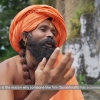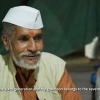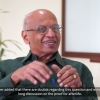My name is Alphi Walter D'Souza. I'm from Vakola and we began the Mobai Goathan Panchayat (MGP) in 2010. That is the year when I resigned from my office to take up full time with MGP. If you go back in history, the East Indian history is pretty old. It's about 400 hundred years old. And from then on till now not much has happened in terms of land, people, culture, all are the same.
In fact, the population is dwindling. At the moment it stands at about 3.5 lakh all over Mumbai, Vasai, Thane and Raigad. Number one is because by definition itself, our East Indians, they are not very much; the families are thinly populated. Within the family, they don’t produce much like others, you know that is one reason. The second reason is that we are spread all over now. So many of our East Indians have migrated, the local population is automatically thinned down.
Actually, all of the people living in Mumbai worked for East India Company; it being the only company at that time. Then slowly came the Goans from Goa and Mangaloreans from Mangalore and south Indians from Tamil Nadu and all that. So, the East India Company people, they were getting confused whom to call what. Goans and Mangaloreans as Goan and Mangaloreans and south Indians but they didn’t know what to call the locals.
That is why they labelled them as East Indians. We regret that also today. Because East Indians is not the correct name if you ask me, and people think that we have come from Calcutta. But now we find that we can’t do anything. We had a long discussion on this, 2-3 hours deliberating on this only, but we found that it is better to leave it untouched. Otherwise what would happen is there would be too much confusion.
The first question I asked the Chief Minister…because the previous Chief Minister did not know who East Indians were okay. . .so luckily he had heard about East Indians. I said thank God for that you know. So awareness has grown in the last 5-6 years, I think like never before. In the last 40 years, if you take, and you take only the last 3-4 years, awareness has gone really high.
Now everybody knows who the East Indians are, most of them know what they are, their traditions are, why they are, where they are and that they are the original landowners. That also has come in some way or the other. I think the Kolis are as original as the East Indians because wherever there is sea there Kolis are present. Also, East Indians, wherever there was agriculture to be done there were East Indians there. We are basically agriculturalists. So that's why we were there in Bombay and Bombay was a totally agricultural area until I think East India Company came in and swallowed most of our people into their workplace.
Actually initially there were 169 gaothans (villages) but today if you see BMC records it just records about 70 or 80 gaothans. That is because of the urbanisation of the gaothans. Many gaothans have disappeared with the tall structures coming in, so there is no gaothan look only. With that, I think many gaothan have disappeared and our gaothan population has come to 60 to 70.
Gaothans would include houses, typical houses of the Portuguese era, and there are very few now in a few villages like Kurla, Kalina, Vakola, Bandra has quite a few, and many more at the Dharavi belt that is Manori to Uthan. Most of us have grown up in such houses only. Now there are very few. Like one in Charni Road, Khotachiwadi, James Ferreira’s house if you see, that's a typical East Indian house.
When we were kids the gaothan was a place where everybody knew everybody, everybody mingled with everybody. There was lot of merrymaking during festivals, marriages, and Christmas. It was all celebrated together. Today, everybody is in their own houses or flats or whatever, that is a major difference. So far as games also, every day we used to play on the open grounds. I don't see kids playing today. Today, it’s cosmopolitan, it’s a mixed crowd, you have everybody. We have welcomed everybody.
Recently, a fortnight back we were with the Chief Minister. That was one of our main demands, that please demarcate the gaothans. Tell us where our gaothans are on paper so that we can say, okay now we don’t develop that area. He knows that and he said, yes I have instructed the BMC to demarcate the gaothans. He was very receptive so at least we are hoping it will start now. May not be finishing in his term but if they start now something, at least, will happen. The government has generally said they are heritage precincts but they have not put a tag. But I have said that you put a number to each one. They are not doing that.
We have something called Agera, where we bring paddy from Gorai and Norel. We get it blessed and distribute it in the church. This signifies the start of the harvest season. Then the church feast, each parish has its own church. So we have a day-long festival. Then there is Christmas for everyone. Easter is there. These are the main festivals. If you see the churches from Manori to Uthan, the Marathi ones, where the medium is Marathi because people understand Marathi. The masses are in Marathi and in the other churches, the masses are in Marathi once a month. Some have twice a month, depending on the population and the people interested.
See automatically when we have these functions, they all know. Because we have with them with a band and a lot of merry noise and all that. So everybody knows it is our function. There are boards and banners put up and we tell people also. From the mic also we announce that this is our festival which was there for 100 years and we would like to continue now. That's why we are having it.
What we are doing as far as possible, every celebration, every feast, we are trying to celebrate everywhere. Like there is a feast before Lent. That time we fast. Before that 40-day fast, we have one day where we celebrate. So what we have done is we have requested all the gaothans to have this celebration. So that the tradition goes on and many gaothans are doing that now.
During our marriages, one day prior to the main ceremony, we have something called Unthaza paani le, where we go to the well to take water. Tradition has it that water was taken for the bride to bathe in the morning. So they still go to the well though the wells are not very clean so they fill water from some houses and they bring back. The ceremony takes place at night only at about 10 o'clock or 11 o'clock. But then immediately after 10 if the music goes on—we go with the band and all that—the cops come in, somebody complains, you know.
These are all those residents who have come afterwards. Those who have migrated and they complain. So they don't know the tradition and things like that. Most like the idea also and they know, in their own native place, they have the same thing only, doing very similar things. Here they can't do that because they are thinly populated or they are scattered.
To fight back is very difficult. Because they have all the money power, the police and everything with them. So very difficult to fight that. Though we are fighting to keep the tradition alive as far as possible.
Related to marriage only there are 3-4 you know. One is a dinner the night after the wedding. Of course, that is prevalent almost everywhere but here what happens is the people, we collect some money and have a sort of picnic. Wherein each one gives INR 100 and something like that. And they only have fish on that day, fish menu.
Like any community, today all communities are intermingling like never before. So are the East Indians. See happiness is the basic underlining feature, whoever the poor person marries must be happy. There is no point in marrying an East Indian and being unhappy. So we don't interfere.
History said that the Mount Mary Church in Bandra was plundered in the 16th Century or so. In the 17th Century, they brought the statue which was kept at Mahim Church. Every year they used to bring the statue, place it there, have the devotion for eight days and then take it back. So what we did is we revived the thing in a very short form. We got the statue on a tonga (cart) with people coming and the band playing from Mahim to Bandra St.Peter's. There we said a few prayers and along with many more people, we walked to the mount with the statue and the procession, with the police and all at the side.
It was a good sight; we had about 200-300 people. Next year we hope to have more. We want to continue this tradition. Now a lot of these competitions are there, East Indian; those are held in almost every village at different points of time. This has got crowds coming in at full capacity. Food festivals are there, again at full capacity. People from one village mingle with another and all that. So these are telltale signs, that say yes, the traditions are getting revived day by day.
See the OBC certificate that was issued to us in 2006, they said all East Indians can get OBC certificates. But we are not getting it because the government requirement is too much. They are asking for great-grandfather's birth certificate to prove that we are born and brought up here. We are showing them all land holdings, 7-12 extracts, 6-12 extracts; but still, on some pretext or the other, they are rejecting our applications. So we have brought this to the notice of the Chief Minister also. He said he will see to that also. We want a little simplified OBC certificate process.
There are four main bodies or NGOs who are working for the East Indians and every village, every gaothans has its own association. There are about 40+ gaothans which have associations and four main bodies. Mumbai Gaothan panchayat is one of them, Bombay East Indian Association is another one, then Maharashtra East Indian Federation is one more and then Nooral Sangathana is one more.
Each one works separately, but when a common cause comes; suppose the crosses are demolished by the BMC and all, then we all get together and sort it out. When there are associations working for the same cause more or less, then there will be little conflicts but then we agree to disagree and we go ahead.
See, we mostly work for a cultural revival. With that in mind, we started the museum. The museum was one of our pet projects and we started it early in 2010. We were also born in 2010, the Mumbai Gaothan Panchayat, and immediately jumped on this museum project. For two years it was in two hearts. Then now today it is a golden edifice. You have seen the museum, so that is the result now.
There are about 100 plus artefacts. Kitchenware is among the highest number of our artefacts. All those mud pots, in which we used to cook, are there. Then there are some instruments of the profession like the agriculturalist, the tailor, then what you called the bandari, i.e., the toddy tapper; all those articles are there. Besides that, there is furniture and jewellery.
Every year we try to improve and upgrade it in some way or the other. Now our idea is to expand it a little more because some of the artefacts are yet to come in, at least 30 odd artefacts are to come in. We are trying to work out how to at least put the picture of the artefact there.
We collect by word of mouth, basically. And during our festivals and all we announce. And somebody who has, like this gentleman from Bandra, he called me and said that I have got a bit of forma which is no use now to me because we don't do anything so you please keep it in the museum.
Actually, we want the museum to be run by the government we don't want it private. Now, it is private and it is on private land, till the government gives us the land, which the Chief Minister has promised us. We are hoping that he gives us somewhere there only, because here there is no land in Bombay, as everybody knows. So we had told him that we don’t mind in that area because we already have a small museum so that we can make it big. He said he will give the letters to the concerned authorities and then he will tell us whom to meet. Maybe 15 days down the line.
This newsletter first started in Juhu, for Juhu Gaothan only. Then one day while brainstorming we said why not adapt it for the entire Mumbai region? Then in 2010 - 2011, we took it for the entire Mumbai region. Now we are printing about 3500 copies and emails are about 18,000 that go out and they go out to Canada, Dubai, Australia and everywhere wherever our people are. It is available to anybody who wants it. It is online plus there are hard copies for those who are not online.
These are lay people of the community, some who write occasionally and some who write regularly. So as a team, we just spread the word we need an article on this festival or some other incident then somebody inputs it. Basically the news of the day, then there are some instructions and you know, some requirements, funding, etc. All this finds a place.
Then some pictures are also there. We have an essay competition now. Yesterday was the last day for all Mumbai, open to everybody, all schools; 45 schools participated. And then from tomorrow onwards we are doing the shortlisting and then giving it forward to the judging panel, expert panel. We try monthly and then sometimes we have once in two months.
Uttan Heritage Village was formed by some people, East Indians. Some East Indians have a full-fledged bungalow in that village. It is a big village set up where people will have their own bungalows and others could come in and go back. They wanted to recreate a gaothan but that didn't happen, unfortunately. Now it is just barren land and members are fighting over it.
Actually, our community is so old and today it is like a deprived community almost. With so much land at our disposal at one time, today we are ourselves scrambling for a little land, you know, here and there. Maybe all the churches in Bombay have been donated by the East Indians but that time nobody bothered about the land. But with development coming into Mumbai, all land was gone.
So, today I think at least if we had that East Indian Bhavan or something, which we are hoping to; at least East Indians can come there and have a good time, once in a year or once in six months. They revive memories, they talk about the old times, the good times, that way.












